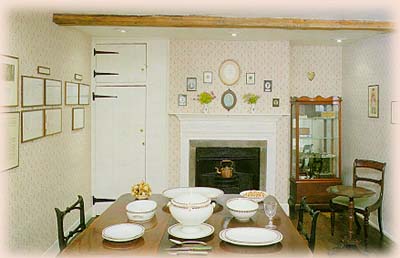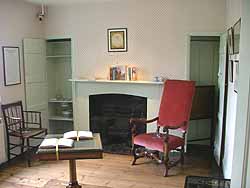Jane Austen’s novels centered around topics she knew best: hearth, home, neighborhood, and family. The following excerpts offer glimpses of the houses that Jane Austen described in her novels. Accompanying photos illustrate the interior of Chawton, a home in which Jane’s talents as a writer thrived. In Jane Austen’s Idea of a Home , S. M. ABDUL KHALEQUE discusses the difference between Jane’s ideal of a warm and loving home and the architectural characteristics of an impressive ancestral house:
In Mansfield Park, Austen makes it clear that physical facilities become useless if moral values are not properly cultivated. Although the houses like Rosings, Sotherton Court, and Northanger Abbey are spacious and magnificent, these are not worthy of consideration as homes. In contrast, the small-sized house of the Harvilles in Persuasion is a home because it exemplifies orderliness as well as other virtues, and the members of the family are always full of life and spirit in their house. Similarly, the Crofts turn their rented house—Kellynch Hall—into a home, a feat that Sir Walter, the owner of the estate, failed to perform; hence, his departure for Bath. What Jane Austen suggests is that physical facilities will be charming only when there is a correspondence between outward beauty and the inner life. Pemberley unites these qualities, and that precisely is the reason why it is a home, whereas some of the great houses are not.
This excerpt from Sense and Sensibility, Chapter 5, demonstrates that the John Dashwoods consider furniture to be symbols of possessions and wealth, not items to be cherished in their home:
Mr. John Dashwood told his mother again and again how exceedingly sorry he was that she had taken a house at such a distance from Norland as to prevent his being of any service to her in removing her furniture. He really felt conscientiously vexed on the occasion; for the very exertion to which he had limited the performance of his promise to his father was by this arrangement rendered impracticable.– The furniture was all sent around by water. It chiefly consisted of household linen, plate, china, and books, with a handsome pianoforte of Marianne’s. Mrs. John Dashwood saw the packages depart with a sigh: she could not help feeling it hard that as Mrs. Dashwood’s income would be so trifling in comparison with their own, she should have any handsome article of furniture.
Contrast the above description with Lizzy Bennet’s first visit to Pemberley. As she wanders through the stately rooms of Mr. Darcy’s house, Elizabeth is struck as much by the mansion’s magnificence as by its attraction as a home:
The rooms were lofty and handsome, and their furniture suitable to the fortune of its proprietor; but Elizabeth saw, with admiration of his taste, that it was neither gaudy nor uselessly fine; with less of splendour, and more real elegance, than the furniture of Rosings. “And of this place,” thought she, “I might have been mistress! With these rooms I might now have been familiarly acquainted! Instead of viewing them as a stranger, I might have rejoiced in them as my own, and welcomed to them as visitors my uncle and aunt.”
Expectations loomed large for poor Catherine Morland when she received an invitation to visit Northanger Abbey. She hoped to finally get to see, feel, and experience a romantic and mouldering house like those described in her Gothic novels! Imagine her let-down when she accompanied General Tilney on a tour of the Abbey and realized he had modernized its grand yet comfortable rooms:
They set forward; and, with a grandeur of air, a dignified step, which caught the eye, but could not shake the doubts of the well-read Catherine, he led the way across the hall, through the common drawing-room and one useless antechamber, into a room magnificent both in size and furniture–the real drawing-room, used only with company of consequence. It was very noble–very grand–very charming!–was all that Catherine had to say, for her indiscriminating eye scarcely discerned the colour of the satin; and all minuteness of praise, all praise that had much meaning, was supplied by the general: the costliness or elegance of any room’s fitting-up could be nothing to her; she cared for no furniture of a more modern date than the fifteenth century. When the general had satisfied his own curiosity, in a close examination of every well-known ornament, they proceeded into the library, an apartment, in its way, of equal magnificence, exhibiting a collection of books, on which an humble man might have looked with pride.
Contrast Catherine’s disappointment with this cozy Christmas scene in Persuasion with two of the Harville children visiting Uppercross as Louisa recovers from her fall in Lyme Regis.
Immediately surrounding Mrs. Musgrove were the little Harvilles, whom she was sedulously guarding from the tyranny of the two children from the Cottage, expressly arrived to amuse them. On one side was a table occupied by some chattering girls, cutting up silk and gold paper; and on the other were tressels and trays, bending under the weight of brawn and cold pies, where riotous boys were holding high revel; the whole completed by a roaring Christmas fire, which seemed determined to be heard, in spite of all the noise of the others. Charles and Mary also came in, of course, during their visit, and Mr. Musgrove made a point of paying his respects to Lady Russell, and sat down close to her for ten minutes, talking with a very raised voice, but from the clamour of the children on his knees, generally in vain. It was a fine family-piece.
To read more about this topic, click on these additional Links:











